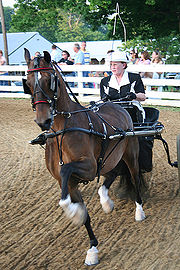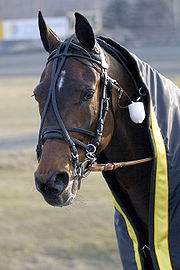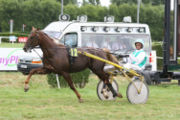
Bearing rein
Encyclopedia

Horse tack
Tack is a term used to describe any of the various equipment and accessories worn by horses in the course of their use as domesticated animals. Saddles, stirrups, bridles, halters, reins, bits, harnesses, martingales, and breastplates are all forms of horse tack...
that runs from a point on the horse's back, over the head, to a bit
Bit (horse)
A bit is a type of horse tack used in equestrian activities, usually made of metal or a synthetic material, and is placed in the mouth of a horse or other equid and assists a rider in communicating with the animal. It rests on the bars of the mouth in an interdental region where there are no teeth...
. A bearing rein is used to prevent the horse from lowering its head beyond a fixed point. A variation, called a side check, passes beside the ears through loops at the top of the bridle cheekpieces
Bridle
A bridle is a piece of equipment used to direct a horse. As defined in the Oxford English Dictionary, the "bridle" includes both the headstall that holds a bit that goes in the mouth of a horse, and the reins that are attached to the bit....
.
It can be attached to the surcingle
Surcingle
A surcingle is a strap made of leather or leather-like synthetic materials such as nylon or neoprene, sometimes with elastic, that fastens around a horse's girth area. A surcingle may be used for ground training, some types of in-hand exhibition, and over a saddle or horse pack to stabilize the load...
of a horse harness
Horse harness
A horse harness is a type of horse tack that allows a horse or other equine to pull various horse-drawn vehicles such as a carriage, wagon or sleigh. Harnesses may also be used to hitch animals to other loads such as a plow or canal boat....
, or to the harness saddle.
A bearing rein shares some function with side reins, draw reins, and the de Gogue
Gogue
The Gogue or de Gogue is a piece of horse tack used for training purposes, and is very popular in Europe, with a similar place in training regimes as side reins...
, and has the opposite function to a chambon
Chambon
A chambon is a piece of horse tack. It is a strap that runs forward from the bottom of the girth or surcingle, and forks. The forks continue to a ring on either side of the bridle or halter, at the base of the crownpiece. Running through those rings, the forks follow the cheekpieces to the bit...
and martingale
Martingale (tack)
A martingale is any of several designs of tack that are used on horses to control head carriage. Martingales may be seen in a wide variety of equestrian disciplines, both riding and driving...
. It can be attached to the same bit as the rein
Rein
Reins are items of horse tack, used to direct a horse or other animal used for riding or driving. Reins can be made of leather, nylon, metal, or other materials, and attach to a bridle via either its bit or its noseband.-Use for riding:...
s, or to a second, separate bit.
Use

An overcheck has a practical purpose; if a horse lowers its head too far when in harness, particularly if moving quickly, it can catch the bridle on the shafts of the carriage or wagon, risking an accident. Properly adjusted and when used for a limited period of time, an overcheck does not significantly impede the motion of the horse or cause discomfort. If too tight, however, an overcheck rein can be uncomfortable because it puts strain on the neck muscles and ligaments. On a hard-working draft horse
Draft horse
A draft horse , draught horse or dray horse , less often called a work horse or heavy horse, is a large horse bred for hard, heavy tasks such as ploughing and farm labour...
, it generally is not used at all, as it puts the animal off balance by preventing it from lowering its head when trying to pull significant weight. A horse pulling weight normally lowers and extends its neck in order to distribute the load. If an overcheck is inappropriately used, or used for too long a period, spinal strain resulting in neck or back injury can occur.

Equestrianism
Equestrianism more often known as riding, horseback riding or horse riding refers to the skill of riding, driving, or vaulting with horses...
activities, and for certain types of horse training
Horse training
Horse training refers to a variety of practices that teach horses to perform certain behaviors when asked to do so by humans. Horses are trained to be manageable by humans for everyday care as well as for equestrian activities from horse racing to therapeutic horseback riding for people with...
. In particular, it is used on certain saddle seat
Saddle seat
Saddle Seat is a style of horseback riding within the category of English riding that is designed to show off the high trotting action of certain horse breeds. The style developed into its modern form in the United States, and is also seen in Canada and South Africa...
horses while on the longe line
Longeing
Longeing or lungeing is a technique for training horses, where a horse is asked to work at the end of a long line and respond to commands from a handler on the ground who holds the line. It is also a critical component of the sport of equestrian vaulting...
as part of a bitting rig
Bitting rig
A bitting rig or bitting harness is a training tool for horses that can teach a horse to accept a bridle and bit, and later assist a horse in developing the necessary musculature for a given equestrianism discipline...
that assists the horse in learning the proper high set head position for competition that also emphasizes high knee action. While not normally used by a rider in the saddle
Saddle
A saddle is a supportive structure for a rider or other load, fastened to an animal's back by a girth. The most common type is the equestrian saddle designed for a horse, but specialized saddles have been created for camels and other creatures...
, it is common in some places to put an overcheck on ponies
Pony
A pony is a small horse . Depending on context, a pony may be a horse that is under an approximate or exact height at the withers, or a small horse with a specific conformation and temperament. There are many different breeds...
when being ridden by very young riders in order to prevent the pony from putting its head down and grazing while being ridden, an act of disobedience that a small child often lacks the physical strength to prevent.
The overcheck is generally not used to train dressage
Dressage
Dressage is a competitive equestrian sport, defined by the International Equestrian Federation as "the highest expression of horse training." Competitions are held at all levels from amateur to the World Equestrian Games...
horses, because it can lead to the horse traveling with a hollow frame, the opposite of the rounded frame encouraged in dressage. A device that looks similar, the chambon
Chambon
A chambon is a piece of horse tack. It is a strap that runs forward from the bottom of the girth or surcingle, and forks. The forks continue to a ring on either side of the bridle or halter, at the base of the crownpiece. Running through those rings, the forks follow the cheekpieces to the bit...
, is sometimes used in training of dressage horses. However, the chambon encourages the horse to lower, not raise, its head. The Gogue
Gogue
The Gogue or de Gogue is a piece of horse tack used for training purposes, and is very popular in Europe, with a similar place in training regimes as side reins...
is a related training tool.
History
In the 18th and 19th centuries, the overcheck, then called a "bearing rein," was commonly used on stylish carriage horses to keep their heads up, at times to an extreme degree, depending on the fashion of various periods. Today it is used primarily for horse showHorse show
A Horse show is a judged exhibition of horses and ponies. Many different horse breeds and equestrian disciplines hold competitions worldwide, from local to the international levels. Most horse shows run from one to three days, sometimes longer for major, all-breed events or national and...
or exhibition use, particularly in the schooling and showing of fine harness
Fine harness
Fine harness is a type of driving competition seen at horse shows, that feature light, refined horses with high action. Popular breeds in this event include the American Saddlebred, Morgan, Arabian, Dutch Harness Horse, and Hackney ....
horses and certain types of carriage
Carriage
A carriage is a wheeled vehicle for people, usually horse-drawn; litters and sedan chairs are excluded, since they are wheelless vehicles. The carriage is especially designed for private passenger use and for comfort or elegance, though some are also used to transport goods. It may be light,...
horses.
Historically, improper use and overuse created chronic problems with the spine and back that in some cases made certain horses useless as working animal
Working animal
A working animal is an animal, usually domesticated, that is kept by humans and trained to perform tasks. They may be close members of the family, such as guide or service dogs, or they may be animals trained strictly to perform a job, such as logging elephants. They may also be used for milk, a...
s. The fashion extremes of the 18th and 19th centuries at times tightened a bearing rein to the degree that it made breathing difficult. This is touched on in the novel Black Beauty
Black Beauty
Black Beauty is an 1877 novel by English author Anna Sewell. It was composed in the last years of her life, during which she remained in her house as an invalid. The novel became an immediate bestseller, with Sewell dying just five months after its publication, long enough to see her first and only...
.
The term bearing rein is derived from the definition of "bearing" which means "The manner in which one bears or conducts one's self; mien; behavior; carriage." The reference suggested that high head carriage was a sign of nobility or pride. However, 19th century critics of the bearing rein applied a pejorative meaning to the word, meaning "Patient endurance; suffering without complaint". Modern harness trainers prefer the more accurate terminology "overcheck" and "check rein"
Related equipment
A related type of checkrein often used in conjunction with an overcheck are side reinsSide reins
Side reins are equipment used when longeing a horse, running from the bit of the bridle to the saddle or surcingle. As a horse training tool, they encourage flexion and softness in the horse's mouth. For longe work with a rider up who does not carry ordinary riding reins, they help calm and...
or a side check, a pair of reins which run simply from the bit to a surcingle
Surcingle
A surcingle is a strap made of leather or leather-like synthetic materials such as nylon or neoprene, sometimes with elastic, that fastens around a horse's girth area. A surcingle may be used for ground training, some types of in-hand exhibition, and over a saddle or horse pack to stabilize the load...
or saddle
Saddle
A saddle is a supportive structure for a rider or other load, fastened to an animal's back by a girth. The most common type is the equestrian saddle designed for a horse, but specialized saddles have been created for camels and other creatures...
, intended to keep the horse's head tucked in. Side reins are a very common training tool for working horses on the longe
Longeing
Longeing or lungeing is a technique for training horses, where a horse is asked to work at the end of a long line and respond to commands from a handler on the ground who holds the line. It is also a critical component of the sport of equestrian vaulting...
, also considered standard safety equipment in the sport of equestrian vaulting
Equestrian vaulting
Equestrian vaulting, or simply Vaulting , is most often described as gymnastics and dance on horseback and, like these disciplines, it can be practised as a non-competitive art/performance or as a competitive sport. Vaulting has been an equestrian act at the circus from its early days. It is open...
, but rarely if ever are used by a mounted rider.

